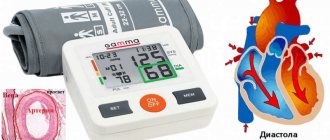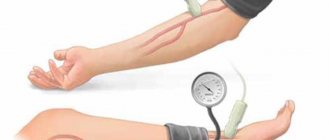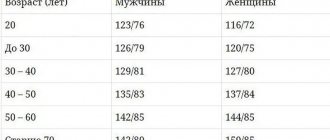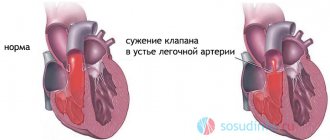Blood pressure is the force with which blood exerts on the walls of arteries, veins and capillaries to move through the body's vascular system. The formation of pressure involves vascular tone, the volume of blood ejected from the heart muscle at one time, and heart rate. Deviations in the functioning of the cardiovascular system lead to an increase or decrease in pressure parameters.
In the process of measuring pulse pressure, two parameters are used:
- upper or systolic - blood pressure that occurs at the moment of contraction of the left ventricle of the heart;
- The lower or diastolic pressure is measured when the heart muscle relaxes.
The upper pressure indicates the normal functioning of the heart, and the lower pressure indicates peripheral vascular tone (the ability to tense and relax the walls of blood vessels).
The concept of normal blood pressure
By blood pressure we mean the force with which the blood pumped by the heart “pump” presses on the vessels. The pressure depends on the capabilities of the heart, on the volume of blood that it can distill within one minute.
Subscribe to our INSTAGRAM account!
Clinical picture
Tonometer readings may change for various reasons:
- The strength and frequency of contractions that cause fluid to move through the bloodstream;
- Atherosclerosis: if there are blood clots on the vessels, they narrow the lumen and create additional stress;
- Blood composition: some characteristics can be purely individual; if the blood supply is difficult, this automatically causes an increase in blood pressure;
- Changes in the diameter of the vessel associated with changes in the emotional background during stress and panic;
- The degree of elasticity of the vascular wall: if it is thickened, worn out, this interferes with normal blood flow;
- The thyroid gland: its performance and hormonal capabilities that regulate these parameters.
The tonometer readings are also influenced by the time of day: at night, as a rule, its values decrease.
Emotional background, as well as medications, coffee or tea, can both lower and increase blood pressure.
Everyone has heard about normal blood pressure - 120/80 mm Hg. Art. (these numbers are usually recorded at 20-40 years of age).
Up to 20 years of age, the physiological norm is considered to be slightly low blood pressure – 100/70. But this parameter is quite conditional; for an objective picture, it is necessary to take into account the permissible interval for the upper and lower limits of the norm.
For the first indicator, corrections can be made in the range of 101-139, for the second - 59-89. The upper limit (systolic) of the tonometer is recorded at the moment of maximum heart contractions, the lower limit (diastolic) – at complete relaxation.
Blood pressure standards depend not only on age, but also on gender. For women over 40, 140/70 mmHg is considered ideal. Art. Minor errors do not affect health; a significant decrease may be accompanied by unpleasant symptoms.
Blood pressure has its own age norm:
- 16-20 years: 100-120 / 70-80;
- 20-30 years: 120-126 / 75-80;
- By the age of 50, a person’s normal blood pressure reaches 130/80;
- After 60, tonometer readings of 135/85 are considered normal;
- At the 70th year of life, the parameters increase to 140/88.
Our body is able to control blood pressure itself: with adequate loads, blood supply increases, and tonometer readings increase by 20 mmHg.
Art.
Age differences in blood pressure norms
What is normal blood pressure for a person? An important point is that children, adolescents and adults, men and women have differences in blood pressure and heart rate.
Age standards are presented in the tables below.
Children
| Age | Minimum | Maximum |
| Up to 2 weeks | 67 to 40 | 96 to 50 |
| 2-4 weeks | 80 to 40 | 112 by 74 |
| 8 weeks-1 year | 90 to 50 | 112 by 74 |
| Up to 1.5 years | 100 to 60 | 112 by 74 |
| 3-5 years | 100 to 60 | 114 by 72 |
| 6-9 years | 106 by 674 | 125 by 75 |
There are a number of factors that affect a child's blood pressure levels:
- Age - the older the child, the higher the pressure, this is due to the fact that the vessels develop and their tone increases;
- Height - the shorter the child, the lower his blood pressure;
- Weight – the more weight, the higher the blood pressure;
- Gender – boys have higher blood pressure than girls.
Minor deviations in blood pressure from normal in a child may indicate that the cardiovascular system is not developing in proportion to age.
In such cases, it is advisable to show the child to a specialist to make an accurate diagnosis, but there is a possibility that after a certain time the situation will stabilize and there will be no need to prescribe medications for treatment. It is much more important that the child’s lifestyle is correct. If a child engages in physical activity, blood pressure may be elevated. This is due to the fact that vascular tone increases during sports.
Teenagers
| Age | Minimum | Maximum |
| 10-12 years | 110 to 70 | 127 by 70 |
| 12-15 years | 116 by 70 | 136 by 76 |
| 15-20 years | 110 to 70 | 130 to 90 |
In adolescents, the normal value may be increased, this is due to hormonal changes, the so-called puberty. At this time, it is important to visit a cardiologist and endocrinologist so as not to miss the moment when treatment is needed. If the doctor has not identified any pathologies, then the blood pressure will return to normal as the child grows up.
Adults
Normal indicators:
| Age | Men | Women |
| 20 | 122 by 76 | 117 by 72 |
| 30 | 124 by 79 | 120 by 75 |
| 40 | 129 by 81 | 127 by 79 |
| 50 | 137 by 82 | 137 to 85 |
| 60 | 142 by 85 | 144 by 85 |
What is normal blood pressure for an adult? As you can see, in an adult, systolic blood pressure increases with age and diastolic blood pressure decreases. This is due to the structure of the body, the vessels lose their elasticity and tone. High heart pressure is almost always hereditary.
It is important to note that in women aged 35-40 years, the average blood pressure is 150 over 80 - this is normal, although it is not within the normal range, it is not a cause for concern; this indicator is associated with gender and the structural features of the female body.
In children and adolescents, blood pressure may also temporarily rise during educational activities due to fatigue and intense brain activity.
In each individual case, the reasons are purely individual, related to the unique structure of the body, and only a doctor after diagnosis should know for sure whether medical care is needed and it should be provided.
Often the scale increases in pregnant girls, this is due to the fact that during pregnancy hormonal changes in the body occur, organs are compressed during pregnancy, this puts additional stress on the heart and blood vessels of the body. But, if after childbirth your blood pressure does not return to normal, you should consult a doctor.
Normal blood pressure and pulse by age: table for adults
Data on the limits of normal blood pressure can be conveniently studied in the table. In addition to the upper and lower limits, there is also a dangerous interval, which indicates unfavorable health trends.
With age, upper blood pressure increases, and lower blood pressure increases only in the first half of life; in adulthood, its indicators stabilize and even fall due to a decrease in the elasticity of blood vessels. Errors within 10 mmHg. Art. are not considered pathologies.
| Type of blood pressure | Blood pressure values (mm Hg) | Comments | |
| min | max | ||
| Hypertension stage 4 | from 210 | from 120 | symptoms of hypertensive crisis |
| Hypertension stage 3 | 180/110 | 210/120 | |
| Hypertension stage 2 | 160/100 | 179/109 | dangerous blood pressure readings |
| Hypertension stage 1 | 140/90 | 159/99 | |
| Prehypertension | 130/85 | 139/89 | |
| Slightly elevated blood pressure | 90/60 | 129/84 | normal blood pressure readings |
| Normal blood pressure (ideally) | 100/65 | 120/80 | |
| Slightly low blood pressure | 90/60 | 99/64 | |
| Moderate hypotension | 70/40 | 89/59 | |
| Severe hypotension | 50/35 | 69/39 | dangerous blood pressure readings |
| Severe hypotension | Up to 50 | Up to 35 | |
If there are symptoms of a hypertensive crisis, the patient needs urgent hospitalization. If blood pressure levels are dangerous, you need to take medications.
Summary table of normal blood pressure indicators for women 20 – 80 years old
Normal blood pressure in men and women aged 20–80 years is not very different from that in men. Significant differences appear after 50 years, when a woman’s body undergoes serious hormonal changes.
The degree of change in arterial parameters in women is well reflected in the table of pressure by age:
| Age | Systolic value | Diastolic value |
| 20 | 115-120 | 73-75 |
| 30 | 120 | 76-80 |
| 31-40 | 120-126 | 76-80 |
| 41-50 | 126-136 | 80-86 |
| 51-70 | 145-160 | 86 |
| 71-80 | 157-160 | 83-86 |
| 81-90 | 150 | 79 |
Peculiarities of pulse in adults
Normally, an adult’s heart rate ranges from 60 to 100 beats/min. The more active metabolic processes occur, the higher the result. Deviations indicate endocrine or cardiac pathologies.
During the period of illness, heart rate reaches 120 beats/min, before death – up to 160.
In old age, the pulse should be checked more often, since a change in its frequency may be the first signal of heart problems.
Heart rate slows down with age. This is explained by the fact that the tone of children's blood vessels is low and the heart contracts more often in order to have time to transport nutrients. Athletes have a lower pulse rate because their hearts are trained to spend energy sparingly. An abnormal pulse indicates various pathologies.
- Too frequent a rhythm occurs with thyroid dysfunction: hyperthyroidism increases heart rate, hypothyroidism decreases it;
- If your resting heart rate consistently exceeds the norm, you need to check your diet: perhaps the body does not have enough magnesium and calcium;
- Heart rate below normal occurs with excess magnesium and pathologies of the heart and blood vessels;
- An overdose of medications can also cause changes in heart rhythm;
- Heart rate, like blood pressure, is affected by muscle loads and emotional background.
During sleep, the pulse also slows down; if this does not happen, there is a reason to see an endocrinologist and cardiologist.
By checking the pulse in time, the chances of detecting the problem in time increase. For example, if your pulse quickens after eating, food intoxication is possible. Magnetic storms reduce blood pressure in weather-dependent people. To restore it, the body increases heart rate. A tense pulse indicates sudden changes in blood pressure.
How to measure and evaluate your heart rate
This is interesting: Frequent urination in women without pain: causes, symptoms + TOP-5 treatment methods
The speed of heart contractions is influenced by many factors: emotional state, food intake, alcoholic drinks and energy drinks (for example, coffee), smoking, sleep, ambient temperature and humidity, time of day.
Therefore, the calculation of indicators is carried out in complete mental peace, on an empty stomach. It is advisable to do this immediately after sleep, or at least 15-20 minutes before the measurement, take a comfortable position, sitting or lying down, be sure to lean your back on the surface.
The day before you should not smoke, drink alcohol or drink coffee. Do not count in a stuffy, hot room.
The measurement is usually taken on the radial artery, located on the inside of the wrist.
It is best to feel the pulse wave with the index and middle fingers, since they are more sensitive than the thumb.
Heart rate calculation
Sometimes, with weak beats and in small children, the heart rate is measured on the side of the neck, where the carotid artery is anatomically located.
Immediately the shocks are felt from both sides, and if the shocks are symmetrical, the count is carried out on one hand.
If the pulse beats are uniform, you can count the beats in 20 seconds and multiply by three. We evaluate the obtained result using the table.
| Age | Minimum heart rate value | Maximum heart rate value | Average heart rate |
| From 0 to 1 month | 110 | 170 | 140 |
| From 1 to 12 months | 105 | 165 | 135 |
| From 1 to 2 years | 95 | 155 | 125 |
| From 4 to 6 years | 85 | 125 | 105 |
| From 6 to 8 years | 75 | 115 | 95 |
| From 8 to 10 years | 65 | 105 | 85 |
| From 10 to 12 years | 60 | 100 | 80 |
| From 12 to 15 years | 55 | 95 | 75 |
| From 15 to 50 years | 60 | 80 | 70 |
| From 50 to 60 years | 65 | 85 | 75 |
| From 60 to 80 years | 70 | 90 | 80 |
It has been noticed that most often the heart contracts in newborns. As you grow older, this figure decreases until the age of fifty, and then rises slightly again. It should be noted that in females the number of pulse beats is 5-8 per minute more .
How dangerous is blood pressure deviation?
Everyone knows that normal blood pressure is an important criterion for health, but what do deviations from the norm mean?
If the error exceeds 15 mmHg. Art., this means that pathological processes develop in the body.
The reasons for the decrease in blood pressure may be:
- Genetic predisposition;
- Overwork;
- Hypocaloric nutrition;
- Depressive states;
- Climate and weather changes.
Hypotension can be distinguished by absent-mindedness, rapid fatigue, loss of coordination, memory loss, increased sweating of the feet and palms, myalgia, migraines, joint pain, and increased sensitivity to weather changes. As a result, performance is significantly reduced, as is the quality of life in general. Worries include cervical osteochondrosis, gastrointestinal ulcers, hepatitis, pancreatitis, cystitis, rheumatism, anemia, tuberculosis, arrhythmia, hypothyroidism, cardiac pathologies.
Treatment consists, first of all, in lifestyle modification: control of sleep patterns (9-10 hours) and rest, adequate physical activity, four nutritious meals a day. The necessary medications are prescribed by the doctor.
The reasons for increased blood pressure are:
- Hereditary factors;
- Nervous exhaustion;
- Unhealthy diet;
- Physical inactivity;
- Obesity;
- Abuse of salt, alcohol, smoking.
Hypertension can be distinguished by fatigue, poor quality of sleep, headaches (usually on the back of the head), discomfort in the heart, shortness of breath, and neurological disorders. The result is disturbances in cerebral blood flow, aneurysm, neuroses, and cardiovascular pathologies.
Prevention and treatment consists of following a daily routine, giving up bad habits, changing the diet towards reducing its calorie content, limiting salt and fast carbohydrates.
Adequate physical activity (swimming, dancing, cycling, walking up to 5 km) is required. The doctor will draw up an appropriate drug therapy regimen.
Increased blood pressure
If a person’s normal blood pressure increases by 15 mmHg or more, then this is considered to be an increase in the indicator. However, you should pay attention to the fact that a single deviation of blood pressure from the norm can occur even in a completely healthy person. The alarm should only be sounded if elevated levels persist for a long time. You should also consult a medical specialist if you have health problems that may be caused by abnormal blood pressure values. We will tell you how to determine this below.
Is it possible to lower blood pressure on your own?
High blood pressure is a sign of our time, with which most adults are familiar. The cause of this problem may be:
- Cholesterol seals on the walls of blood vessels;
- Age characteristics;
- Hereditary predisposition;
- Problems in the functioning of internal organs;
- Bad habits (alcohol, smoking, overeating);
- High stress background;
- Hormonal imbalances.
At the first signs of hypertension, you should not experiment with pills; it is better to start with milder methods, for example, herbal medicine.
- Hawthorn, especially in combination with rosehip, effectively restores blood supply and the functioning of the heart muscle.
- Among the most popular herbal remedies for normalizing blood pressure are valerian root and flax seeds , which have a sedative effect.
- Adherents of therapeutic breathing exercises will enjoy the procedure, which eliminates weakness and high (up to 160/120) blood pressure . The bottom is cut off from a plastic bottle and used as an inhaler: you need to breathe from the wide side, and the air should come out of the neck (the cap is open).
- Special exercises for the cervical spine relieve spasms of tight neck muscles The complex takes 10 minutes.
- For 3-5 minutes, you can self-massage your ears , kneading and rubbing the earlobes and auricle (of course, not in cases where the pressure is under 200).
- A warm (at human body temperature) bath with added salt (up to 10 tablespoons) relaxes and helps you fall asleep quickly. Take 10-15 minutes.
- Walking at a brisk pace for 20-30 minutes will help equalize blood pressure after stress.
- Sunbathing is beneficial for hypertensive patients . In hot countries there are significantly fewer such patients than in northern countries. On sunny days you need to be outside more often.
- A sustainable reduction in blood pressure can be guaranteed by a dairy-vegetable diet .
- Well, those who can no longer do without pills (if the pressure rises significantly) use emergency medications : nifedipine (Corinfar), physiotens, capoten (captopril), bisoprolol and other groups of medications recommended by the doctor.
Of course, not all recommendations are suitable for every organism, but it’s worth a try if the deviations are not so critical. In this case, blood pressure must be measured twice: before the procedure and after it.
How to find out your blood pressure
This is interesting: What medications can you take for headaches during pregnancy? TOP 5 safe products
A parameter such as blood pressure shows the condition of the whole organism, so it is of interest to specialists.
Blood pressure is the force exerted by blood on the walls of blood vessels. It can be systolic and diastolic. The first is recorded during the ejection of blood by the left ventricle of the heart, the second - during relaxation of the myocardium.
Vessels
To find out your blood pressure level, you need to use a device called a tonometer. There are mechanical and electronic blood pressure monitors.
At home, it is easier for a non-specialist to use an electronic tonometer, since it is enough to put the cuff on the wrist and press a button. In addition, electronic meters are often equipped with heart rate monitors , which allows you to evaluate your heart rate, although it is somewhat rough . The disadvantage of these devices is their need for calibration. Without it, over the years of operation they show incorrect results.
Mechanical blood pressure monitors remain the most accurate. They are used by medical professionals, but you can master the skill of measuring blood pressure at home. To do this, you need a tonometer, a cuff with a rubber bulb and a phonendoscope.
As in the case of assessing heart rate, measuring pressure should be carried out in complete physical and emotional rest, on an empty stomach.
Principles of blood pressure measurement
- The subject sits with his back resting on a chair, his arm is freed from clothing, extended at the elbow joint and relaxed. The hand is at the same level as the heart.
- Place the cuff two centimeters above the cubital fossa.
- We install a phonendoscope in the ulnar cavity.
- We close the clamp on the bulb and pump up the pressure in the cuff, slightly higher than the patient’s normal level.
- Slowly open the clamp, at the same time follow the arrow on the pressure gauge and listen to the phonendoscope.
- The first blow in a phonendoscope is upper pressure, the last is lower.
It is advisable to measure three times with an interval of five minutes. If the numbers differ, the minimum indicators are considered true.
Blood pressure measurement
An error of 5 units is allowed on different hands. Too large a discrepancy requires additional examination.
How can you raise blood pressure at home?
What pressure is considered normal? Have you found out what can provoke a sharp drop in blood pressure?
- A critical decrease in glucose concentration in the bloodstream;
- A drop in hemoglobin levels in the blood;
- Chronic lack of sleep or other type of overwork;
- Problems with digestion, gastrointestinal tract performance;
- Changes in climate zone and weather conditions;
- Thyroid dysfunction;
- Critical days and premenstrual period;
- Hypocaloric diet.
If blood pressure is consistently low, it is important to balance the diet, diversify the diet with fatty meats and fish, hard cheese and other high-fat dairy products.
Various seasonings and dried fruits are useful - pepper, ginger, raisins, figs
Do tea and coffee affect blood pressure readings?
Medical opinions differ regarding the effects of hot or cold black tea on the body. Some do not recommend it for hypertensive patients due to the high concentration of caffeine, others believe that this drink tones blood vessels and lowers blood pressure. Green tea is especially useful in this regard, as it has the ability to normalize any blood pressure when consumed regularly and correctly.
Natural coffee gently increases blood pressure in hypotensive patients. It cannot increase blood pressure to a critical level for hypertensive patients, but they should not abuse this drink.
Many are probably familiar with the results of an experiment by French scientists who suggested that twin prisoners with life sentences drink only tea every day for one and coffee for the other in order to find out which of the brothers would live longer. The prisoners outlived all the scientists involved in the study and died well into their 80s, with only minor differences.
Prevention of blood pressure deviations
A fashionable way to gradually lower blood pressure is floating , when the patient is placed in a special sealed chamber. The bottom of the capsule is filled with warm salt water. The patient is created conditions for sensory deprivation, eliminating access to any information - light, sound, etc.
The first to try this vacuum technique were astronauts. It is enough to attend this procedure once a month. Well, a more accessible and no less important procedure is regular blood pressure measurement.
The ability and habit of using a tonometer is a good prevention of most ailments. It’s a good idea to keep a diary where you will regularly note readings for monitoring blood pressure dynamics.
You can use simple but effective recommendations:
- A manual tonometer requires some skills; the automatic version can be used by everyone without any problems.
- Blood pressure should be checked in a calm state, since any stress (muscular or emotional) can significantly correct it. A cigarette or a heavy lunch distorts the results.
- Blood pressure should be measured while sitting, with back support.
- The hand where blood pressure is checked is placed at the level of the heart, so it is convenient for it to lie on the table.
- During the procedure, you must sit still and silent.
- For objectivity of the picture, readings are taken from both hands with a break of 10 minutes.
- Serious abnormalities require medical attention. After additional examinations, the doctor can decide on a way to eliminate the problem.
Is the heart capable of pumping the required volumes of blood? With age, the blood thickens and its composition changes. Thick blood moves more slowly through the vessels. The causes of such changes may be autoimmune disorders or diabetes. Vessels lose elasticity due to poor nutrition, physical overload, and after taking certain medications.
The picture is also complicated by an excess of “bad” cholesterol in the blood. Hormones or malfunctioning endocrine glands sharply change the lumen of blood vessels.
A significant part of the causes of blood pressure changes can be eliminated yourself.
Normal blood pressure is a guarantee of high performance of the heart muscle, endocrine and nervous systems, and good vascular condition. Monitor your blood pressure regularly and stay healthy!
Factors influencing blood pressure in women
Blood pressure is an indicator showing how hard the blood in the body presses on the vessels. Accordingly, it is directly related to the work of the entire cardiovascular system, namely:
- The intensity of heart contractions;
- Elasticity of blood vessels;
- Volumes of the heart chambers;
- The degree of patency of the arteries.
Despite the fact that there are certain norms for blood pressure, its actual indicators often deviate significantly from them. The main factors influencing this process are:
- Age. It is so inherent in nature that at different times a person’s blood pressure can naturally both increase and decrease;
- Floor. Women and men actually have different intensity of heart work, and therefore different blood pressure standards. The difference is not significant, but still there;
- Heart diseases. The human heart is a unique organ that works every second. But under the influence of various pathologies and increased overload, it can wear out faster, which cannot but affect pressure indicators;
- Thickness of blood. Too thick blood leads to various diseases, as it becomes difficult for the heart to pump it and additional effort is required;
- Elasticity of blood vessels. This is a very important indicator on which blood circulation in the body as a whole and, accordingly, blood pressure levels depend. Elasticity can deteriorate under the influence of both natural processes, such as aging, and various additional factors. For example, the presence of cholesterol plaques can significantly impair vascular conductivity.
Blood density is one of the factors influencing blood pressure levels.
As you can see, quite a lot of causes of pressure surges are associated with pathologies and disturbances in the functioning of internal systems. In order to prevent their occurrence, it is important to understand what can provoke them. These factors include:
- Passive lifestyle. If a person does not experience at least moderate physical activity, the supply of oxygen to the blood and, accordingly, to the tissues deteriorates. This affects the functioning of blood vessels and the heart;
- Abuse of bad habits. Alcohol and cigarettes contribute to the entry of toxins into the body, which clog blood vessels, contribute to the accumulation of cholesterol, and impair the functioning of organs, including the heart;
- Frequent stress, emotional swings, nervous tension. Probably everyone is familiar with the fact that in such conditions a person’s heartbeat and pulse quicken, blood flow to the head increases and blood pressure rises;
- Nature of nutrition. Abuse of unhealthy fatty foods inevitably leads to clogged blood vessels and impaired blood flow. The expected result is regular pressure surges;
- State of the environment. The cause of high or low pressure can be temperature, excessive dry air, the presence of pollution, etc.
A passive lifestyle is one of the factors influencing blood pressure levels.
Another important point is that blood pressure levels vary by age. This means that the same numbers cannot be taken as the reference value of blood pressure in childhood and, for example, in the elderly. What standards correspond to women will be discussed below.










